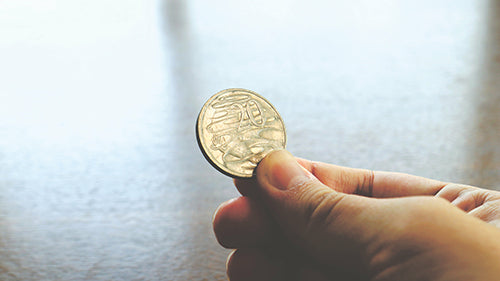The following was penned by Downies employee Jimmy…
Now, while you may have already seen the informative infographic we posted last week, and pictured to the right, this blog post will go into a bit more detail, pointing out exactly what you need to be looking for while searching through your pocket money.
Australia’s first variety takes us back to the beginning of decimal currency, and the highly sought after 1966 Wavy Line 20c. This key type is thus named because the bottom stroke of the 2 in the denomination appears to have a wave at the top, rather than the straight line seen on other 20c coins. To cater for the massive amount of currency required at decimalisation, the then new Royal Australian Mint was joined by Britain’s Royal Mint for the production of 1966 coinage, and it was at the latter that a small number of 20c coins were struck with a slightly different die, creating the Wavy Line 20c variety. Prices for Uncirculated examples have been known to fetch up to $3,000, with even an EF example worth more than $1,000, and, as a result, I routinely check every 20c piece I receive in change. The Royal Mint did strike normal versions of the coin, which brings us to our next collectable variety...
Although many people are unaware that different mints struck the 1966 20c, knowledgeable collectors do tend to seek out examples from each mint – and there is one quick way to find out if you have a Royal Mint or RAM version in your hand. If you have a look at the water ripples around the platypus, there is a ripple that comes into contact with the right side of its head. This is where the difference between the mint variations will be apparent. A ripple that touches the head of the platypus will indicate the coin is from the Royal Mint, whereas a ripple that has a slight gap between the head will indicate a RAM coin! Both can demand good prices from collectors, so as a rule of thumb, if you get a 1966 20c in change, pay close attention to it!
The next 20c in the series to look out for was issued in 1981. In this particular year, industrial action at the Royal Australian Mint saw Australia once again seek the assistance of mints overseas, with Britain’s Royal Mint and the Royal Canadian Mint called into action. Now, while mintage figures from both overseas mints are similar, it is the coins struck at the Royal Canadian Mint that prove most popular with collectors. The Royal Canadian Mint 1981 20c can be distinguished by examining the claws on the left paw of the platypus, located directly under the 2 in the denomination. All other coins from 1981 have 4 claws on the left paw, but coins struck at the Canadian mint have a claw on the far right that appears to be half missing! This distinctive type is consequently known as the ‘Three & a Half Claws’ variety.
No analysis of 20c varieties could possibly ignore the famed 1981 Scalloped 20c. Coming to light late in 1982, this is a VERY RARE coin which, whilst you almost certainly will not have seen in change. Assisting the production of Australian 20c coins during the aforementioned industrial action at the RAM, the Royal Mint apparently struck some coins using scalloped blanks intended for use for $2 coins for Hong Kong, for whom it also struck currency. Amazingly, some of these coins made it into circulation!
Although less than 10 examples of this stunning coin have come to light, with the type currently cataloguing at $7,500 in Extremely Fine, who knows whether another one might arise in the future? Always check your change!






